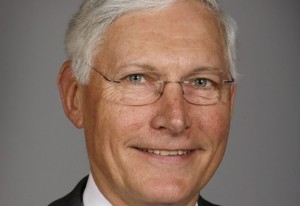Vander Linden Capitol Update for April 9
Iowa’s Expenditure Limitation Law
Iowa’s expenditure limitation law was created in a time of budget turmoil. Throughout the 1980’s, Iowa faced a number of fiscal challenges that caused the state to be unable to meet the funding obligations made by the Legislature. These issues reached a head in 1992, when the Iowa Supreme Court ruled that Governor Branstad was required to provide raises to unionized state employees even though the state did not have the money to pay them.
The Supreme Court’s ruling forced the Governor and legislative Democrats (the majority party at the time) to rewrite the FY 1993 budget. In the end, the Legislature and the Governor were forced to increase the state’s sales tax from 4 to 5 percent. That required bipartisan cooperation, and the price for that cooperation from legislative
Republicans was the creation of the cash reserve fund and economic emergency fund. Also part of the deal was the creation of an expenditure limitation law
Iowa’s expenditure limitation law is in Iowa Code section 8.54. The law says the governor is prohibited from proposing and the Legislature is prohibited from passing a General Fund budget that spends more than 99 percent of the total of projected ongoing revenue (minus revenue adjustments) and remaining ending balance from the previous year. For FY 2016, the calculation is as follows, according to documents from the non-partisan Legislative Fiscal Agency:
FY 2016 Ongoing Revenue (March 2015 estimate):
$7.1755 billion
– Revenue Adjustments passed by the House $0.0009 billion
+ Ending Balance transfer
$0.3872 billion
TOTAL
$7.561.8 billion
$7.5618 billion x 99 percent = FY 2016 expenditure limit of $7.4900 billion.
For over 20 years, this law has provided the upper limit as to what the state could spend in any year. But one flaw in the law has been that the law still allows governors and legislators to spend more than 100 percent of on-going revenue. This fact was repeatedly brought up by former Des Moines Register columnist David Yepsen, who frequently would call out both parties for spending more than the state annually takes in. His warnings were not heeded.
This practice of spending more than the state took in occurred with regularity in the previous decade. And when economic conditions turned south, the state had no ending balances to make up for revenue shortfalls like it does in FY 2015. Schools and service providers suffered the consequences as governors and general assemblies were forced to implement across the board cuts to make sure the state’s books balanced.
Just how bad can this situation get? Let’s look to the current fiscal year. At the start of the 2014 legislative session, the projected ongoing revenue for FY 2015 was $6.9832 billion. The ending balance for FY 2014 – after raising the state reserve funds to the required level -was projected to be $724.7 million. The expenditure limitation calculation for the new budget was $7.6315 billion. The Legislature could have spent up to that amount and complied with the law.
But things changed once the Legislature adjourned. Fiscal Year 2014 revenue came in nearly $200 million below expectations. The state was starting the new fiscal year already behind what had been projected. At the same time, commodity prices began to fall significantly below previous year levels. Those in the agriculture community saw a major slowdown in spending, rippling across the rest of Iowa’s economy. Ongoing revenue is no longer expected to be $6.9832 billion – it has been lowered to $6.7674 billion
Had the state spent up to the expenditure limitation law last year and used all the ending balance from FY 2014, the state would still be almost $150 million short of funding its obligations. This would mean across the board cuts or raiding the state’s reserve funds. What about FY 2016? Since there would be no ending balance, the Legislature and Governor would be limited to spending 99 percent of the
Revenue Estimating Conference’s on-going projection. The FY 2016 budget could not spend more than $7.1037 billion – a reduction of $527.8 million. That amount would nearly equal the general aid appropriation to the three state universities.
When Iowa adopted the expenditure limitation law in 1992, it was a major budget reform that helped get the state’s books back in order. But today, the law has become obsolete as it is used as an excuse for some to advocate for spending well beyond the state’s ongoing revenue. As children across Iowa have learned from their parents, just because the law says you can do something it doesn’t mean you have to. And just because legislators can spend more than the state takes in each year, it doesn’t mean they should. History has shown that it usually leads to serious pain later for schools and those who provide critical services to Iowans.
Problems Continue to Plague Unopened Fort Madison Prison
Over a year after the Iowa State Penitentiary at Fort Madison was scheduled to open, the prison sits empty. Guards patrol the perimeter and inside of the buildings, lights are on and electric bills are being paid but there is still no set date to transfer prisoners. As costs continue to rise, the House Oversight Committee continues to seek answers and find solutions to this seemingly endless problem.
After two inmates escaped the maximum security prison in 2005, plans were created for a new, state of the art prison.
In 2008, the estimated construction cost of the prison was $130.7 million, and in October of 2013 a ribbon cutting was held. Since that time the new prison has faced multiple equipment problems and design flaws that have prevented the prison from being occupied.
In late 2013, prison officials found problems with the geothermal system. Pumps installed with the geothermal system were found to be the wrong size in many buildings and corrective changes had to be made. These changes could cost the state $6.7 million. As of today, the geothermal systems have been fixed and Department of
Corrections Officials believe they will continue to work.
After geothermal issues were fixed, the prison failed a required smoke evacuation test. In order to receive a certificate of occupation from the fire marshal, smoke must be able to be cleared through the ventilation system. Unlike a regular building, windows cannot simply be opened in a prison to clear smoke. The solution for this problem has yet to be found, but approximately $350,000 has been spent to design and test solutions. The actual cost for the fix has yet to be determined, but it is expected to be costly. It is unclear who will pay for these changes.
Two additional problems have also been brought to light in the past few months. Air leaks in some of the buildings have required water to be shut off when temperatures dropped. Officials are working to find the air leaks and a solution to the problem. As of now, there is no estimated cost for repair to these air leaks. Additionally, there are more problems with the ventilation system, separate from the smoke-clearing problems. There is no estimated time or cost for these repairs.
Almost a year and a half after the projected opening date, there is still no end in sight to the problems at Fort Madison. The House Government Oversight Committee has continued to review documents sent by the Department of Administrative Services and the Department of Corrections. Unfortunately, there is no quick solution to these problems but the Oversight committee is working to ensure these issues never happen again in a public project and that the parties responsible for these problems cover the costs and not the Iowa taxpayer.
















